Iberis umbrella - a beautiful and unpretentious plant for the garden
Iberis is a common ornamental plant. It can often be seen in flower beds, gardens and front gardens. This is a flowering and unpretentious plant that covers the flower bed with a single carpet. The flowers of the Iberis are so densely arranged that the foliage is almost invisible, the Iberis umbrella is also famous for its pleasant delicate aroma. Gardeners love this plant for its long and beautiful flowering and ease of maintenance.
Content:
- Description and application of Iberis umbrella
- Breeding methods and planting
- Care Tips
- Diseases and pests
Description and application of Iberis umbrella
Iberis belongs to the Cruciferous family, but unlike most plants of this family, Iberis is not eaten. This is an exclusively ornamental plant that is designed to decorate flower beds, lawns, front gardens.
Features of the structure of Iberis:
- Iberis umbrella really looks like an umbrella. Its inflorescences are rather flat and wide. From a distance it may seem that this is one large bud, but the inflorescence consists of a large number of small flowers (1 cm in diameter).
- The colors can be of different colors: from pure white to bright pink, lilac.
- The plant is a perennial shrub up to 40 cm high. The bushes are rather compact with large inflorescences. In their natural environment, these plants are found in the countries of Central Europe. The name of the flower comes from the ancient name of Spain - Iberia. This plant is also called Iberian, a variety of petals.
- Iberis does not differ in dense foliage. Usually the stem is rather bare, pubescent with few leaves.
Iberis umbellate is usually grown in open ground, since it is somewhat large for potting. But if you wish, you can decorate balconies and gazebos with this flower. Iberises go well with various flower beds. They bloom for a long time, about a month, so they are ideal for flower beds.
Some argue that Iberis also has medicinal properties, but the umbrella variety of this flower is rarely used for medicinal purposes.
Usually, flowers and seeds are plucked from Iberis, which are then used for medicinal purposes. The ground parts of the plant are quite bitter in taste, but are considered beneficial for the functioning of the cardiovascular system. Also, Iberis decoctions are used for various diseases of the gastrointestinal tract, to increase appetite. The flowers have a choleretic, analgesic and tonic effect.
Iberis contains not only useful, but also quite poisonous substances. Medicines from this plant must be prepared with caution and dosage. It is not recommended to use this herb without consulting a doctor. It is also contraindicated in pregnant and lactating women and infants.
Breeding methods and planting
Iberis umbellate is usually propagated by seeds, but vegetative propagation is also possible. The choice of breeding method depends on the wishes of the gardener, but the annual Iberis umbrella is much easier to propagate by seed. It is great for beginners.
Iberis breeding methods:
- The seeds can be purchased at the store or collected by yourself.Iberis umbellate forms pods, which contain seeds. The pods are not only formed in autumn, they ripen unevenly throughout the summer, so it is recommended to harvest them as they ripen. The pods are dried, the seeds are removed and stored in a dry, dark place until the sowing process.
- Iberis is recommended to be propagated by seedlings, but some growers sow seeds directly into open ground at the first warmth. Sow seedlings it is necessary in March, so that in May it is already planted in the ground. If the seeds are sown directly into the ground, then it is better to do this not earlier than mid-April.
- If you decide to breed Iberis cuttings, then the cuttings must be harvested after flowering. Undamaged cuttings up to 5 cm long are cut off. The cut cut can be immediately planted in the ground and create greenhouse conditions. To accelerate rooting, phytohormone solutions are used. It is worth remembering that Iberis flowers are very lush and grows well. To obtain a dense flower carpet, the distance between seedlings should be at least 15 cm.
Seeds for seedlings are sown not in one large box, but immediately in small containers, since Iberis does not really like transplants and does not tolerate them well. Seedling soil can be purchased at the store. It is slightly moistened, and the seeds are deepened a little, by 1 mm.
In order for the seeds to sprout well, the containers are placed in a warm, bright place and greenhouse conditions are created: they are covered with foil or glass.
Seedlings must be regularly ventilated to prevent seeds from rotting. Seedlings should be watered regularly, but waterlogging should be avoided. The light should be diffused so that burns do not form on the leaves.
If the seeds are planted directly in open ground, you must first make shallow grooves, and then put the seeds there. Sowing depth - no more than 1 cm.
In order for the Iberis to bloom all summer, you can plant the plant twice a season: in May and in July. With proper care, the flowering period reaches 1.5 months.
Care Tips
Iberis umbrella is famous for its unpretentiousness. It only takes minimal maintenance to grow this plant. Even a beginner can grow Iberis. However, it is not worth throwing the flower at all. In order for the plant to bloom magnificently for a long time, you need to follow simple rules for caring for Iberis:
- Iberis needs regular watering, but does not tolerate clay soils, where moisture is retained. Before planting it, you need to choose a place with sandy or rocky soil, which will allow air to flow to the roots. If the soil is dense, good drainage is essential. Iberis needs to be watered with a small amount of water as the soil dries out. If the summer is too hot, water more often. It is impossible to flood the plant too much, to allow stagnation of water, since the roots of Iberis quickly begin to rot.
- Usually by the fall, Iberis is pruned, but Umbelliferous Iberis is an annual, so pruning is not necessary. It is enough to collect the seeds. Withered flowers must be removed. This will heal the plant and give the flower bed a neat appearance.
- The flowerbed needs to be weeded regularly to weeds did not interfere with the growth of the shrub. Weeds take nutrients from the soil and deplete it.
- Iberis does not need frequent feeding. It is more important not to overdo it than to underfeed. For the most lush and long-lasting flowering, 2 dressings per season will be enough: when the first leaves appear and at the beginning of flowering. For feeding, you can use complex mineral fertilizerspurchased from specialized stores.
- Iberis loves light and tolerates heat quite well. The plant blooms best in full sun, but can grow in partial shade. It should be borne in mind that shading can affect the size and number of flowers.
- The annual Umbellifer Iberis is removed entirely in the fall. It is advisable to dig up the soil, remove all roots and large stones. This will help avoid weeds.
- It is also important to periodically loosen and weed the soil. This will allow the roots to be saturated with oxygen, and moisture will not stagnate. Without loosening, a crust forms on the surface of the soil, which prevents air from penetrating to the roots.
- After removal, it is better to burn dead plants, since they can contain the larvae of various insects.
Diseases and pests
Iberis diseases can be associated with improper care (fungal diseases due to waterlogging) or with various pests, insects that feed on plant sap:
- Downy mildew. This disease affects Iberis with excess moisture: too frequent or heavy watering, prolonged rains. The disease is caused by a fungus, the spores of which successfully overwinter in the remains of shoots and leaves, which is why it is recommended to burn the remains of plants. The course of the disease can stop on its own in dry and hot weather, without frequent watering. You can treat the disease with special drugs or folk remedies such as a garlic solution.
- Keela. This disease affects cruciferous crops. The infection may not be noticed immediately, since it starts from the root. The root system of Iberis is covered with growths and swellings, deformed. Due to root damage, nutrients from the soil do not enter the plant. It begins to dry out, grows poorly, does not bloom. The diseased plant most often dies. To avoid further contamination, you need to process the soil, greenhouse frames, seeds.
- Blackleg. This is a fungal disease that causes the death of the plant even at the seedling stage. To protect plants from this disease, you need to carefully process the soil with a solution of potassium permanganate, sterilize or buy a ready-made, sealed one in a store.
- Earthen fleas. These are small bugs that feed on plants and can jump. Earthen fleas prefer to feed on seedlings or young plants. Bugs leave rounded holes in the foliage of the plant. Earthen flea larvae can lay on leaves or in the soil. Flea beetles are scared away by common tansy. It needs to be spread out between the rows.
- Mealybug. Mealybug infects garden plants, it sucks in and draws nutrients from the plant. Pests leave a white, viscous substance on the plant. You can get rid of insects with a regular soap solution or special disinfectants.
It is best to cultivate the soil before planting the Iberis in advance. Special preparations will allow you to disinfect the soil, destroy insect larvae and fungal spores that cause rotting.
More information can be found in the video:



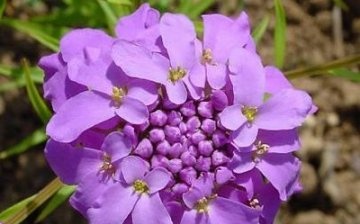
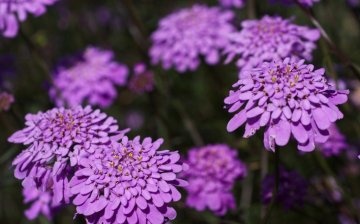
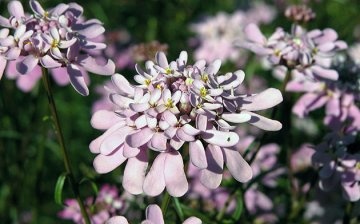
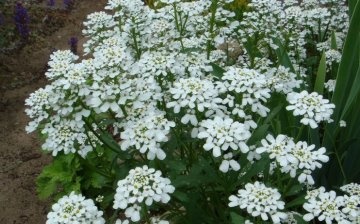
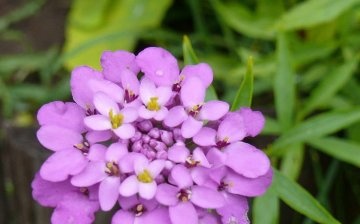





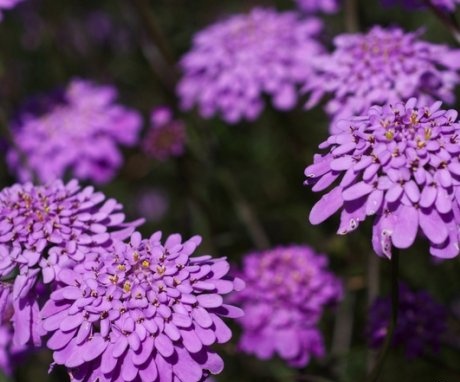
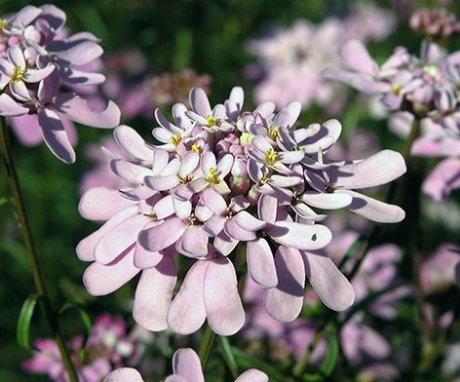
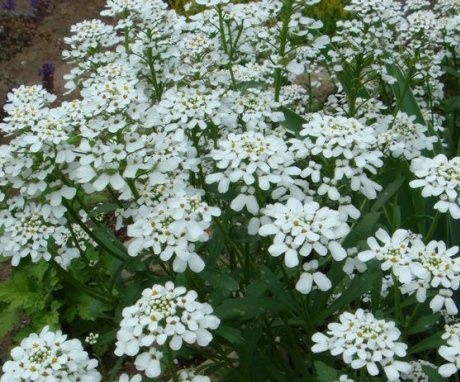
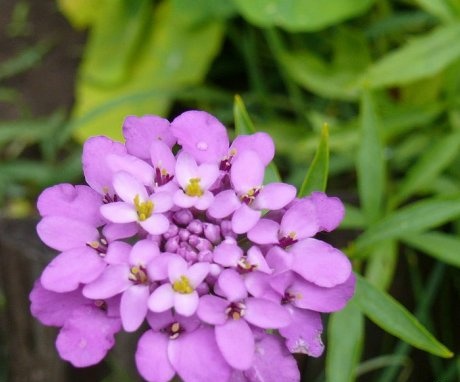
Interestingly, but my Iberis seedlings do not live up to disembarkation. But, having suffered, and still planting stunted blades of grass, I generally stopped following him - Iberis is sown in the most beautiful way on its own. The main thing is not to forget, and not to dig this place in the spring)